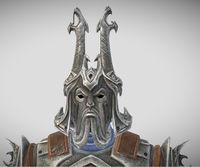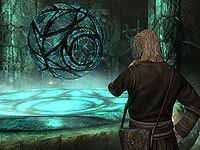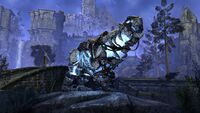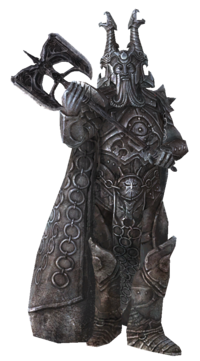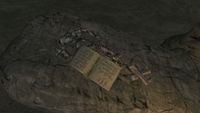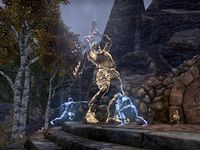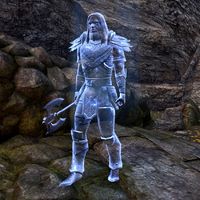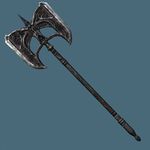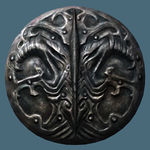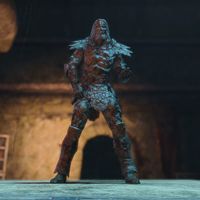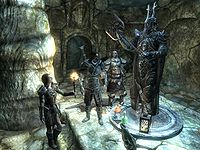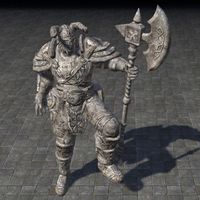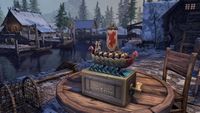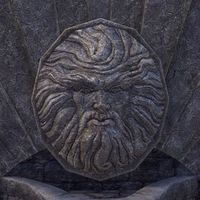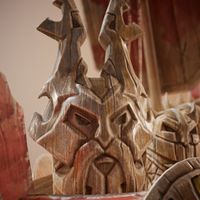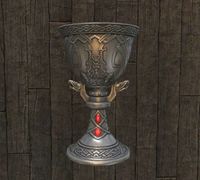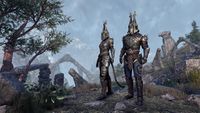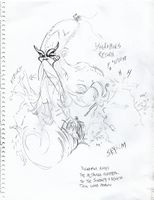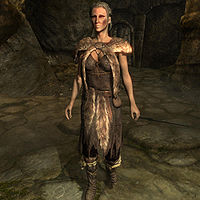Lore:Ysgramor
| Lord Ysgramor | |||
|---|---|---|---|
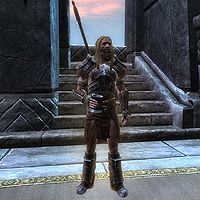 Lord Ysgramor in the Hall of Valor Lord Ysgramor in the Hall of Valor
|
|||
| Race | Atmoran | Gender | Male |
| Born | Merethic Era Atmora |
||
| Died | Skyrim | ||
| Resided in | Atmora Saarthal Windhelm Sovngarde |
||
| Next Ruler | Ylgar | ||
| Appears in | Skyrim, ESO | ||
Ysgramor (sometimes Ysgramoor or Ysgrim),[1][UOL 1] known as Ysgramor the Invader,[2] Ysgramor the Returned,[UOL 2] the Harbinger of us all,[3] Lord,[3] High King, and Hoary King was an Atmoran who came to Tamriel before recorded history as a refugee fleeing civil war in Atmora.[4][5] He is generally regarded as the first human ruler and king of Skyrim.
Some Elven scholars insist Ysgramor was responsible for unspecified "provocations and blasphemies" that led to the genocide known as the Night of Tears, when the human settlement Saarthal was attacked by the Snow Elves and all humans purportedly were slain except Ysgramor and his two sons, Yngol and Ylgar,[6] though some scholars believe this attack was unprovoked.[7] Ysgramor fled back to Atmora, gathered the legendary Five Hundred Companions, then sailed back to Hsaarik Head and drove the Elves from Skyrim and Solstheim, cementing himself as a "culture hero" of the Nords.[4][8][9] He wielded the axe Wuuthrad in battle[10] and rode upon a Storm Atronach Bear conjured for him by his personal Clever Man,[11] Alabar the Oddly-Colored.[UOL 2]
Since he is the first known human to transcribe Nordic speech using Elven principles of writing,[12] Ysgramor is credited with being the first human historian.[4] Because of his exploits, he is known as "the first Harbinger, the first Man, [and] the bringer of Words", and the modern-day Companions still revere him as their only true leader.[13] His progeny ruled Skyrim until 1E 369, when the death of King Borgas brought an end to his direct line of known heirs.[7] However, his bloodline survived,[14] and he is still believed to be the wellspring from whom all Nordic kings are descended.[15]
History[edit]
Life in the Elder Wood[edit]
Ysgramor was born and raised in the northern continent of Atmora, the land was evidently much more temperate in his day than the frozen wasteland it would eventually come to be known as.[7] Certain legends of Ysgramor's Atmoran days exist such as him supposedly spending a day and a night wrestling a giant Chub Loon down from Shivering Glacier.[16] Another yet involves his use of his legendary bow Long-Launcher. Ysgramor often used the bow to hunt in the Atmoran Frostwood. The bow once needed to be re-strung, so Ysgramor collected the laments of the Giant-Wives and brought them to individuals known as Froa and Grosta who twisted them into the Woeful Bowstring. When the bow made use of this new bowstring, it took on a form of sentience, sighing when Ysgramor held it and moaning whenever it was shot.
Ysgramor then used this restrung bow to hunt the White Stag of Forelgrim. It proved near impossible for Ysgramor to land a shot on the stag, as it was quiet and elusive. A hare appeared before Ysgramor and told him that it knew the location of the stag because of its long ears, and that if Ysgramor also had long ears he could hear and successfully track the stag. The hare granted Ysgramor long ears upon his request, but a fox then emerged from the coppice and slew the hare, revealing himself to be Shor. Shor the Fox reverted Ysgramor's ears back to normal and then revealed to Ysgramor that the hare was in fact Herma Mora and nearly tricked him into becoming an elf. He bid him to henceforth rely only on the methods of man and not the tricks of elf lest he become one, and encouraged him to continue his pursuit of the White Stag.[17] This story served as one of many legends that involved Ysgramor and Herma-Mora as an ever present antagonist.[18]
Beyond the more commonly accepted Nordic legends of Ysgramor, others yet speak to his relationship with the Atmoran Dragons and their cult. Ysgramor appears to have had the ancient powers of Thu'um according to various sources. With certain legends speaking to his breath that was weighted with power sounds,[UOL 3] and his act of "Shouting Some Sense" into the Nords.[19] The Thu'um was said to have originated in Atmora,[UOL 4] but only for the Dragon Priests and Dragons themselves.[20]
Some sources claim Ysgramor was himself, a literal Dragon and his name took the style of other dragons: YS GRA MOR,[UOL 5] or Ysmaalithax the Northerly Dragon.[UOL 2] Other sources dismiss this theory and propose it was more likely that he was a Dragon Priest given his stature during the existence of the Dragon Cult, with the rank of "dragon" being an honor bestowed to someone of high stature in the Cult. These ties are believed to be obscured possibly due to people favoring chauvinism over historical truth.[UOL 5]
Settlement of Mereth[edit]
At some point in the late Merethic Era, civil war broke out in Atmora. Ysgramor, his family, and many other Atmorans chose to flee this civil war, sailing south to the continent of Tamriel. Ysgramor and his people landed in the province of Skyrim, at the extreme northern tip of the Broken Cape upon Hsaarik Head.[7][4]
Apparently, some historians have misrepresented Ysgramor as being the leader of the first large group of human settlers from Atmora, when in fact he was merely following what was already a long-established tradition of migration.[7][21]
When Ysgramor arrived to Tamriel, his people brought along their faith of a pantheon consisting of animal gods. Above all these animal totems was that of the dragon. Grand temples were erected by the Atmorans to honor these totems including the dragons themselves who served as living embodiments of the dragon totem.[22] The Atmorans named the land of Skyrim "Mereth" for the Elves that roamed the land. Initially there was peace between Ysgramor's people and the Elves.[7]
Eventually more settlers from Atmora arrived to Skyrim where men had begun to flourish. Ysgramor and his men erected the great city of Saarthal, the first and largest Nordic settlement on Tamriel.[7]
Night of Tears[edit]
Eventually the local elves, namely the Falmer turned on their human neighbors, slaughtering them in great abundance and razing the city of Saarthal, the event would come to be known as the Night of Tears.
Scholars debate on the reason why the Night of Tears took place. With some Elven sources claiming that Ysgramor committed unknown blasphemies to kickstart the conflict.[2] Human sources on the other hand, claim innocence on the matter and cite Elven fear that the young vital race of men would eventually surpass their stagnant culture as cause for the attack.[7] Others yet claim that when the Atmorans built Saarthal, they discovered the mythical Eye of Magnus and despite their best attempts to keep this secret, the elves would learn of this artifact and take Saarthal in an attempt to secure this power for themselves.[23]
Regardless of the reason for the event, utter devastation was dealt to the Atmorans. The only survivors of the Night of Tears were Ysgramor and his two sons Yngol and Ylgar.[7] Ysgramor and his sons managed to reach the last intact ship in their fleet and the trio fled Tamriel back to their homeland of Atmora. As Ysgramor stared across the waters, a storm began to brew and the Harbinger watched as Saarthal burned from afar. Ysgramor was so grief stricken that he began to cry not conventional tears, but that of pure ebony. His son Yngol captured these tears in a stein and then consoled his grief stricken father. From their Yngol, who was the greatest Atmoran smith of his age, began to craft a weapon using the raging storm and his father's ebony tears. The next morning Yngol presented his father the great axe forged from his grief, Ysgramor cried out with emotion and named the weapon Wuuthrad meaning "Storm's Tears" in the Atmoran language.[24][25]
Gathering of the Five Hundred[edit]
When Ysgramor returned to Atmora, he was deeply angered and wished to instantly set sail back to Tamriel to exact revenge on the elves. Instead he calmed himself and took his bow Long-Launcher into the eastern marshes where he slayed Faldrosta the great Snow-Goose. He then plucked a great quill from her corpse and proceeded to use it to develop a runic alphabet based on Elvish principles, which enabled the written transcription of Atmoran speech. Ysgramor's first work in this new form of writing was a chronicle of his own life and its events, solidifying him as the first human historian.[12][4]
Ysgramor sent his sons Yngol and Ylgar to gather the finest warriors of Atmora together to form a fleet of warriors. This mighty fleet consisted of various ships including the ships of Ysgramor's sons—the Darumzu and the Harakk, named after the stars favored by the Atmorans[6]—as well as Jorrvaskr, captained by Jeek of the River, Ysgramor's childhood companion, and the third Harbinger.[13][26] and also the Kaal Kaaz, the Krilot Lok, the Fallowfire, the Sadon Reyth, and the ship of Lord Ysgramor himself, the Ylgermet.[27][28][29] Ysgramor and his mighty Five Hundred Companions being gathered, set sail for Tamriel.
The Return[edit]
During his voyage to Tamriel with his Five Hundred Companions, a great storm was set upon the fleet that was said to have been the works of Kyne herself. Ysgramor lost his son Yngol to the "sea-ghosts" (likely an ancient, superstitious term for the dangers in the Sea of Ghosts),[29] and Ysgramor braved the storm to search for him in the treacherous waters.[6][30] When Yngol was found dead, Ysgramor wept with grief and killed a "dozen dozen beasts" in Yngol's honor.[6][30] One legend of metaphysical nature claims that Ysgramor during the Return took a gigantic form and pushed Atmora closer to Tamriel, so the journey from one of the continents to the other was never as long again.[UOL 6]
When Ysgramor arrived to Tamriel, he and his men camped near the ruins of Saarthal, which the elves had fortified against him. Ysgramor was met by Ahzidal, a legendary Nordic enchanter who had a vendetta against the elves, and thus offered to bedeck the Atmoran's armor and armaments with powerful enchantments, to which Ysgramor happily obliged.[31] One powerfully enchanted armor type were the Gauntlets of the Companions, powerful Dragonplate gauntlets that Ysgramor gifted to some of his most trusted companions to ensure they had the fortitude to keep up with him in his conquests of Skyrim that were to come.[32]
With their combined might, and the help of Ahzidal's enchanted gear, Ysgramor and his companions were able to recapture Saarthal, dealing the Falmer a resounding defeat with great slaughter.[31][26] One particular skirmish within the retaking of Saarthal speaks of Ysgramor confronting the ancient Snow Elf wizard, Serenarth. As both the elves and men fought for control of Saarthal, Ysgramor drew his bow Long-Launcher and managed to strike a decisive blow to the wizard, allowing the Atmorans to move on and reclaim the city.[2]
After Saarthal was retaken, Ysgramor let out a mighty war cry that was said to have been heard even in Atmora, and when the Atmorans heard it they knew it was time for them to set sail for Tamriel. The Companions looked to Ysgramor for what to do next, and Ysgramor bade that the various crews that had sailed together split up and spread out among Skyrim, to continue to eliminate the Falmer and other enemies wherever they may be.[26] This would begin the creation of the First human Empire in Tamriel's history.[2]
Ysgramor and his people rebuilt Saarthal,[33] while his great friend Jeek of the River, and 21 others close friends of Ysgramor, the crew of the Jorrvaskr reached an ancient structure that would come to be known as the Skyforge and built the city of Whiterun around it.[26] Eventually Ysgramor and his crew of the Ylgermet left Saarthal behind, where they came upon Yngol's Barrow, the burial place or Ysgramor's son who had perished during the beginning of the Return.
Ysgramor looked south of Yngol's Barrow where the river met the sea and decided a great city would be built there. With the hands of Atmorans, and elven slaves from prior conquests, the City of Kings, Windhelm was created.[29]
Further Conquests[edit]
A final confrontation between Ysgramor and the Snow Elves took place on the island of Solstheim. Having repelled the elves from the province of Skyrim in near entirety, the Nords were also set on erasing their presence from the island, the conflicts on Solstheim would be concluded with the Battle of the Moesring. The Nords dominated the battlefield with their superior weapons, and it was said that the slopes of the Moesring "ran red with Elf blood".[34]
The turning point came when the Snow Prince rode into battle on a "brilliant steed of pallid white". He parted the ranks of the elves and swooped into Ysgramor's forces. He killed many with his spear and his ice magic, including Ulfgi Anvil-Hand, Strom the White, Freida Oaken-Wand, Heimdall the Frenzied and Jofrior. Finna, the daughter of Jofrior, watched as the Snow Prince killed her mother. In her rage, she threw Jofrior's sword at the Prince, which struck him in the breast and killed him. With their savior lost the Elves fled the battle, and the Nords cut down any who remained.[34]
The fate of the Snow Elves was sealed by their defeat. According to one tale Ysgramor had their noses cut off so they could be distinguished from other Elves, and drove them underground.[35] Those Elves who were driven underground sought refuge with the Dwemer, and in doing so, doomed their entire race. Deep underground in the realm of Blackreach, the Dwemer agreed to provide sanctuary for the refugees. Unbeknownst to the Elves, however, their saviors would exact from them a terrible cost. Mistrustful of their charges, the Dwemer tricked and enslaved the Elves, twisting the once-majestic beings into the Falmer, a race of bloodthirsty creatures made blind by the cruel hands of their masters.[36][37]
According to the skalds of the Bards College, Ysgramor slew so many frost giants that he was covered in their blue blood. The rest of his foes fled the field and frost giants avoided the more populated areas of the province, thereafter becoming much rarer to find.[38] He and his Five Hundred Companions were the first to wear the blue war-paint based on these battles.[38][39] A large number of Giant clans inhabited the land, and were ruled by a powerful chieftain named Sinmur. According to legend, Ysgramor and the Five Hundred Companions fought a large-scale war with Sinmur and his kin, and both sides suffered severe casualties. The conflict culminated in a final battle between the two leaders in Sinmur's barrow. As they dueled, Ysgramor shattered Sinmur's club and finally slew him with his legendary battleaxe, Wuuthrad.[40][41] According to legend, he also defeated a powerful mage known as Lodorr, who forged a magical crown that allowed him to enslave an army of followers.[42]
Ysgramor's death was met with great sorrow and mourning among his kin, and the news quickly spread across Tamriel.[43] Although a grand tomb was built for him beneath Windhelm in preparation for his passing, Ysgramor instead chose to be buried with his most trusted generals in a barrow on the northern shores of Skyrim, facing towards Atmora.[29][44] His son, Ylgar, subsequently took up the mantle of leadership.[41]
Legacy[edit]
In death, Ysgramor journeyed to the Hall of Valor in Sovngarde, where he continued to watch over the Nord people and the Companions. During the Three Banners War, the Order of the Black Worm, led by the necromancer Thallik Wormfather, sought to reanimate Sinmur and an army of his kin.[45][46] With the aid of a Reachmen tribe they attacked Shor's Stone, infiltrated Sinmur's tomb and awakened his spirit.[47] They also stole Wuuthrad from Fallowstone Hall, as the axe had become imbued with great power after slaying Sinmur. The Worm Cult believed this power could be used to raise Sinmur and use him in their schemes.[48]
Ysgramor guided the Heroic Vestige to undo the works of the Worm Cult and put a stop to his old foe Sinmur.[25] Eventually the Vestige with the help of Jorunn the Skald-King was able to deal the worm cult a decisive blow by banishing Sinmur completely.[49] The spirit of Ysgramor and many of his Companions appeared to congratulate the pair directly for the feat before departing back for Sovngarde.[25]
In 4E 201 during the rise of the prophetic Last Dragonborn, Alduin loomed over the Underworld of Sovngarde, devouring souls of the dead to gain power. When the Last Dragonborn arrived to the Hall of Valor, they encountered many heroes including the spirit of Ysgramor, who informed the Last Dragonborn that Shor had bade them keep their blades sheathed, as the fight with Alduin belonged only to the Last Dragonborn, and the three ancient tongues Hakon One-Eye, Felldir the Old, and Gormlaith Golden-Hilt.[50] The four ultimately succeeded in defeating and banishing Alduin.[51]
Artifacts[edit]
Wuuthrad[edit]
Wuuthrad, meaning "Storm's Tears" in the language of Atmora, was the legendary battleaxe wielded by Ysgramor during his conquest of Skyrim in the late Merethic Era. With Wuuthrad in his hands, Ysgramor and his Five Hundred Companions slaughtered an untold number of elves, which culminated in the founding of the First Empire of the Nords. For the Companions, Wuuthrad is a sacred relic which holds a great deal of respect and reverence, and through it they can trace their line straight back to the first Harbinger. It is held to be the greatest of all Nord weapons.
Shield of Ysgramor[edit]
The Shield of Ysgramor was buried within the tomb of that famous hero of the Nords in the Late Merethic Era. It's unknown if Ysgramor ever wielded this shield in battle. The wielder of the shield is both harder to kill and resistant to magic.
Long-Launcher[edit]
Long-Launcher was the legendary longbow artifact of Ysgramor. He used it during many hunts and battles throughout the course of his life in both the Atmoran Frostwood and in Skyrim. During his time in Atmora, the bow once needed to be re-strung, so Ysgramor collected the laments of the Giant-Wives and brought them to individuals known as Froa and Grosta who twisted them into the Woeful Bowstring. When the bow made use of this new bowstring, it took on a form of sentience, sighing when Ysgramor held it and moaning whenever it was shot.
Gallery[edit]
A statue of Ysgramor in Shor's Stone Mine (ESO)
A stone carving found in Windhelm, possibly depicting Ysgramor[2]
Notes[edit]
- Calixto's House of Curiosities in Skyrim had a fork claimed to be Ysgramor's Soup Spoon on display.
See also[edit]
- For game-specific information, see the Skyrim and Elder Scrolls Online articles.
Books[edit]
- Great Harbingers by Swyk the Long-Sighted — Chronicle of some of the leaders of the Companions
- Songs of the Return — Parts of the traditional legend of Ysgramor and his Five Hundred Companions
- Black Book: Untold Legends — A fragmented tome surrounding the other lives of Ysgramor
- Yngol and the Sea-Ghosts — A tale of Ysgramor's first adventure in Tamriel
- The Onus of the Oghma by Phrastus of Elinhir — A selection of quotes to emphasize the importance of recording one's life story
References[edit]
- ^ King Edward, Part X — Anonymous
- ^ a b c d e The Improved Emperor's Guide to Tamriel: Skyrim — Flaccus Terentius, 2E 581
- ^ a b Songs of the Return
- ^ a b c d e Before the Ages of Man — Aicantar of Shimerene
- ^ The Annotated Anuad
- ^ a b c d Songs of the Return, Vol 2
- ^ a b c d e f g h i Pocket Guide to the Empire, 1st Edition: Skyrim — Imperial Geographical Society, 2E 864
- ^ Fall of the Snow Prince — Lokheim
- ^ Vernaccus and Bourlor — Tavi Dromio
- ^ Events of Skyrim
- ^ Storm Atronach Bear mount description in ESO
- ^ a b The Onus of the Oghma — Phrastus of Elinhir
- ^ a b Great Harbingers — Swyk the Long-Sighted
- ^ Anska's dialogue in Skyrim
- ^ Pocket Guide to the Empire, 3rd Edition: The Throat of the World: Skyrim — Imperial Geographical Society, 3E 432
- ^ Atmoran Chub Loon pet description in ESO
- ^ Fragmentae Abyssum Hermaeus Morus
- ^ Varieties of Faith... — Brother Mikhael Karkuxor of the Imperial College
- ^ Five Songs of King Wulfharth
- ^ The Guardian and the Traitor — Lucius Gallus
- ^ Frontier, Conquest — University of Gwylim Press, 3E 344
- ^ The Dragon War — Torhal Bjorik
- ^ Night of Tears — Dranor Seleth
- ^ Songs of the Return, Volume 5
- ^ a b c Ysgramor's dialogue in ESO
- ^ a b c d Songs of the Return, Vol 7
- ^ Valdur's dialogue in ESO
- ^ Songs of the Return, Volume 49
- ^ a b c d Songs of the Return, Vol 19
- ^ a b Yngol and the Sea-Ghosts
- ^ a b Ahzidal's Descent — Halund Greycloak
- ^ Gauntlets of the Companions description in Blades
- ^ Imperial Report on Saarthal — Heseph Chirirnis
- ^ a b Fall of the Snow Prince — Lokheim
- ^ Monsters of Northern Folklore — Minerva Calo, Imperial Chronicler
- ^ The Falmer: A Study — Ursa Uthrax
- ^ Gelebor's dialogue in Skyrim: Dawnguard
- ^ a b Ysgramor's Chosen Body Marking Antiquities Codex from ESO
- ^ Ysgramor's Chosen Body Marking description from ESO
- ^ Songs of the Return, Volume 27
- ^ a b Skald Svari's dialogue in ESO
- ^ Malana's dialogue in ESO
- ^ Songs of the Return, Vol 56
- ^ Vilkas' dialogue in Skyrim
- ^ Events of ESO
- ^ Thallik's Orders — Thallik Wormfather
- ^ Unearthed quest in ESO
- ^ Vigrod Wraithbane's dialogue in ESO
- ^ Stomping Sinmur quest in ESO
- ^ Ysgramor's dialogue in Skyrim
- ^ Dragonslayer quest in Skyrim
Note: The following references are considered to be unofficial sources. They are included to round off this article and may not be authoritative or conclusive.
- ^ The Tenpenny Winter...Again
- ^ a b c The Five Hundred Mighty Companions or Thereabouts of Ysgramor the Returned
- ^ The Seven Fights of The Aldudagga
- ^ Minutes of the Lusty Argonian Historical Society, Evening Star, 3E 432 — Arielle Woodhouse
- ^ a b The Dragon War, documented
- ^ Ysgramor Shade — Michael Kirkbride

